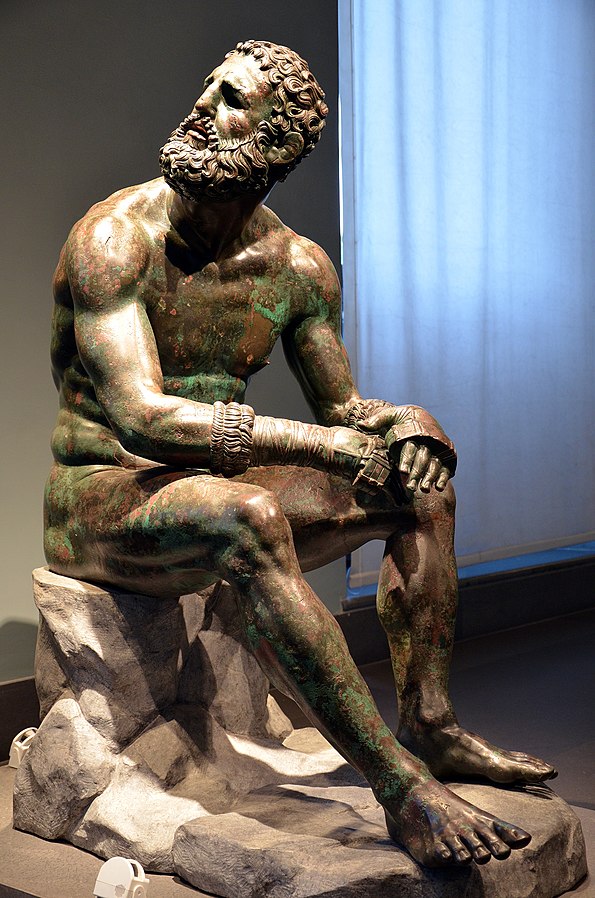

The Hellenistic period significantly departed from the Classical ideals of beauty and perfection that had previously dominated Greek art. Instead of focusing on the idealized forms of gods, athletes, and heroes, Hellenistic artists found inspiration in the most marginal places.
Embracing society’s outsiders allowed Hellenistic artists to explore a broader range of human states, including suffering, defeat, and old age.
The Hag (Old Woman): Outsider realism in Hellenistic art

The “Old Woman” sculptures from the Hellenistic period showcase the era’s shift towards realism. One famous example is the Old Market Woman, a marble statue likely from the late 2nd century BC.
This sculpture depicts an elderly woman carrying a basket of goods, possibly on her way to or from a market. Her hunched posture, wrinkled skin, and weary expression contrast sharply with the idealized depictions of youth and beauty that dominated earlier Greek art.
This sculpture reflects the Hellenistic interest in capturing the full range of human experiences, including those considered less traditionally “beautiful.” The Old Market Woman represents an ordinary person, likely of lower social class, engaged in daily tasks.
This focus on common and overlooked members of society is a hallmark of Hellenistic art. It underscores the period’s cultural shift towards empathy and exploring the human condition.
The sculpture challenges viewers to recognize the dignity and resilience of the elderly while confronting them with the stark realities of aging. Behind the significance of these themes is the celebration of the impermanence of life, reminding the audience of the proximity of death.
The Dying Gaul: A study in realism and pathos

Like the Old Woman theme, the Dying Gaul is a renowned marble statue focusing on a soldier on his last leg. It is believed to be a Roman copy of a Hellenistic original. Sculptor Epigonus likely created the original in the 3rd century BC.
The statue depicts a Gallic warrior lying on the ground, his body contorted in pain in his final moments. He is nude except for a torque around his neck, symbolizing his barbarian heritage.
His face shows exhaustion, agony, and resignation, while his muscles remain tense from the battle. Visible wounds emphasize the violence of his death.
The Dying Gaul exemplifies the Hellenistic fascination with pathos, the emotional appeal to pity or compassion. Unlike the Classical period, which focused on triumphant heroes and idealized forms, this sculpture emphasizes the tragedy of defeat and the universality of suffering.
The detailed portrayal of the Gaul, once an enemy of the Greeks, suggests a broader cultural perspective. It acknowledges the humanity of those who were once foes. The statue invites viewers to see the nobility and vulnerability in the defeated warrior. It offers a poignant commentary on the futility of war and the shared experience of mortality.
The Beaten Boxer: Realism in athletic representation

Like defeat on the battlefield, the realm of performative sports likewise delves into the theme of bowing out with dignity.
The Boxer at Rest, also known as the Beaten Boxer, is a bronze sculpture from the late 4th or early 3rd century BC. This life-sized statue depicts an older, battle-worn athlete sitting down, with his head turned as if hearing a noise or lost in thought.
His muscular body bears heavy scars, broken teeth, and swollen ears. Inlaid copper emphasizes deep cuts, simulating fresh wounds. His expression reveals fatigue, pain, and possibly a deep sense of reflection or defeat.
This sculpture departs significantly from earlier Greek art’s idealized depictions of athletes. Instead of celebrating an athlete at the peak of physical prowess, the Beaten Boxer captures a moment of vulnerability.
It highlights the physical and emotional toll of his profession. The detailed portrayal of injuries and weary posture tells a powerful story about the harsh realities of athletic competition and life.
The statue’s realism and emotional depth embody the Hellenistic era’s interest in individual experience, especially in suffering and introspection.
The depiction of a beaten, exhausted athlete serves as a stark reminder that even celebrated figures experience pain and defeat, making the “Boxer at Rest” a deeply humanizing work.
Animals in Hellenistic art: Realism and the depiction of dogs

Part of the artists’ exploration of the spectrum of human life was humanity’s closest companion, canines. Dogs have been around since the time of the memorial, helping Homo sapiens hunt, forage, and ward off danger.
During the Hellenistic period, artists showed increased interest in the natural world, including more realistic and affectionate depictions of dogs, which appeared frequently in sculptures and mosaics.
One example is the Dog of Alcibiades, a sculpture believed to represent the beloved pet of the Athenian statesman Alcibiades.
This sculpture, along with others from the period, portrays dogs naturally, with attention to details like fur texture, muscle structure, and expressive faces.
The realistic portrayal of dogs in Hellenistic art reflects the period’s broader interest in capturing everyday life and emotional bonds between humans and animals.
Unlike earlier animal representations, often symbolic or mythological, these sculptures and mosaics depict dogs as companions.
They emphasize loyalty, affection, and individuality. This shift towards empathetic and naturalistic representation aligns with the Hellenistic focus on realism and exploring a more comprehensive range of subjects.
It also reflects changing social attitudes, whereby even humble and often overlooked aspects of life gained artistic attention.
Society’s outsiders became the inspiration for Greek art
Hellenistic art encapsulates a deeper resonance of the human condition, acknowledging that beauty and worth can be found in unexpected places.
These artists’ focus on realism, empathy, and the full spectrum of being marked a profound shift in art history, paving the way for future explorations of these themes in Western art.
